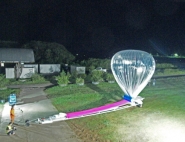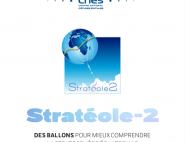Balloons
Strateole 2 balloon structure
Each balloon flown on the campaign comprises:
- a stratospheric superpressure balloon (SPB)
- a ‘suspended payload’, composed of:
- a EUROS ballooncraft and various systems (parachute, separator, venting valve, ballast dispenser, etc.) developed and operated by CNES from a Flight Control Centre (also developed by the agency)
- a Zephyr payload gondola providing the platform for the instruments developed and operated by science teams from a Mission Control Centre (also developed by the science teams)
Each Strateole 2 campaign flies 2 series of balloons at different altitudes, one above the tropopause—the boundary between the troposphere and the stratosphere—at about 20,000 metres and the other at around 18,000 metres, at the top of the tropopause. The first series of flights focuses primarily on remote measurements, and the second on in-situ measurements.
Technological advances in modems, radar responders, solar panels and other components, as well as system design innovations (dynamic management of gas volume, ultra-light and fault-tolerant ballast dispensers, etc.), are enabling balloons to fly for longer and offer greater science payload capacity. The superpressure balloons flown for Strateole 2 are very stable during the day and at night, staying aloft for about three months.
Strateole 2 balloons are 11 or 13 metres in diameter and can carry payload gondolas weighing 22 kilograms. Their closed envelope is filled with helium. The gas initially injected into the balloon expands during its ascent, giving it a spheroid shape when it reaches its ‘ceiling’ altitude of 18,000 or 20,000 metres.
EUROS BALLOONCRAFT AND CONTROL CENTRE
The NSO-Euros ballooncraft ensures flights are conducted in complete safety for aviation and populated areas overflown. It also enables teams at the Flight Control Centre (FCC) to check that the balloon and its systems are functioning correctly. The ballooncraft has its own solar power systems, global communications links (with Iridium and Inmarsat), GPS receiver, processing units and a suite of sensors and active control systems. The FCC uplinks telecommands to keep a close check on the balloon vehicle’s status and make sure the mission runs smoothly and in accordance with safety regulations. As well as its GPS receiver, Euros has a high-precision air pressure and temperature sensing system (TSEN, for Thermodynamical SENsor), developed by the LMD dynamic meteorology laboratory at CNRS, the French national scientific research centre.
All of these systems have a dual operational and scientific vocation. GPS measurements while the balloon is aloft are used to deduce winds, and combined with air pressure and temperature readings to characterize atmospheric waves similar to swell or tidal movements at sea, and even to big breakers in storm conditions.
CNES’s teams at the CASIMIR control centre at the Toulouse Space Centre, in Aire-sur-l’Adour and at the balloon launch site operate and track the flotilla of balloons for the six-month a flight campaign.
PAYLOAD GONDOLA AND CONTROL CENTRE
Not all instruments can be used on all flights due to payload mass constraints. Four combinations of instruments have therefore been devised to achieve the project’s science goals.
These 4 combinations imply as many payload gondola configurations. The Zephyr gondola, developed by LMD, the LATMOS atmospheres, environments and space observations laboratory and DT-INSU (the engineering division at the INSU national institute for universe sciences), carries these combinations of instruments. It has its own dedicated Zephyr Mission Control Centre (CCMz). Science instruments are operated and monitored by the science teams from their laboratories, through the CCMz.
The CCMz manages:
- the flight/ground link for all Zephyr gondolas, and communications and telecommand and data provision/reception services necessary for the mission
- housekeeping of the Zephyr gondola (processing of monitoring telemetry alerts)
- interfaces, data retrieval and transmission of telecommands from scientific instruments to the science teams
Zephyr gondolas carry the following combinations of scientific instruments:
At 20 000 metres
STRAT1
BeCOOL (LATMOS, France/Italy) detects the presence and altitude of clouds up to 5,000 metres underneath the balloon.
ROC (Scripps Institute of Oceanography, USA) has a GPS radio-occultation atmospheric sounder for measuring temperature profiles underneath the balloon.
BOL-DAIR (CNRS-LATMOS) measures upward infrared and solar fluxes.
STRAT2
These flights are solely intended to measure atmospheric dynamics (TSEN and GPS, EUROS ballooncraft) and do not use a Zephyr gondola.
At 18,000 metres
TTL1 (Tropical Tropopause Layer (TTL) in atmosphere)
- SAWfPHY (CNRS-LMD) measures water vapour using the frost-point technique
- B-Bop (CNRS-LMD) detects ozone, which traces the ‘age’ of the air mass, by measuring attenuation of a luminous ultraviolet signal
- LOAC (CNRS-LPC2E) is an aerosol counter that measures particles present at the balloon’s flight altitude
TTL2
- Pico-SDLA (CNRS-GSMA and DT-INSU) measures water vapour and carbon dioxide, a tracer of the ‘age’ of the air mass, measuring attenuation of a laser signal over short distances
- FLOATS (LASP, USA) acquires air temperature profiles within a column 2 km deep, by measuring the temperature of an optical fibre (lidar) deployed underneath the gondola
TTL3
- LOPC (LASP, USA) is an optical counter similar to LOAC
- RACHuTS (LASP, NOAA, USA) is a small gondola winched under the payload gondola (down to 2,000 metres) that acquires profiles of water vapour and air temperature and pressure, and detects particles

